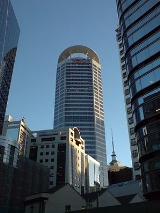
Vero Centre
Encyclopedia
The Vero Centre is a high rise office tower located in Auckland
, New Zealand
. Constructed in 2000, it was Auckland's first major tower built since the 1980s. The centre contains a health club and gymnasium, main entry public foyer, retail outlets in the 5 podium levels and 32 office levels. As of 2005, it is New Zealand’s tallest "and most technologically advanced" landmark office tower. It is also known for its 'halo' roof feature.
While atypically high compared to the surrounding area, its construction is considered to have had a positive effect on the regeneration of the eastern Auckland CBD
area.
The site had previously been occupied by a number of vancant lots and low-rise buildings, including student accommodation, industrial warehouses and massage parlours. The developer's design process for the new site made use of the "bonus provisions" of the District Plan
, allowing them to build more floor area in exchange for public benefits like displayed works of art and a public plaza. The value of these to the general public has however been called into question by some. Also criticised has been the lack of connection between the two frontage streets through the building.
The building received several awards for energy efficiency (such as the RICS International Award for Building Efficiency and
Regeneration in 2001 and the EnergyWise Award 2004), and has been calculated to use around 10% less energy than the average New Zealand Property Council building.
Auckland
The Auckland metropolitan area , in the North Island of New Zealand, is the largest and most populous urban area in the country with residents, percent of the country's population. Auckland also has the largest Polynesian population of any city in the world...
, New Zealand
New Zealand
New Zealand is an island country in the south-western Pacific Ocean comprising two main landmasses and numerous smaller islands. The country is situated some east of Australia across the Tasman Sea, and roughly south of the Pacific island nations of New Caledonia, Fiji, and Tonga...
. Constructed in 2000, it was Auckland's first major tower built since the 1980s. The centre contains a health club and gymnasium, main entry public foyer, retail outlets in the 5 podium levels and 32 office levels. As of 2005, it is New Zealand’s tallest "and most technologically advanced" landmark office tower. It is also known for its 'halo' roof feature.
While atypically high compared to the surrounding area, its construction is considered to have had a positive effect on the regeneration of the eastern Auckland CBD
Auckland CBD
The Auckland CBD is the geographical and economic heart of the Auckland metropolitan area. Bounded by several major motorways and by the harbour coastline in the north, it is surrounded further out by mostly suburban areas...
area.
The site had previously been occupied by a number of vancant lots and low-rise buildings, including student accommodation, industrial warehouses and massage parlours. The developer's design process for the new site made use of the "bonus provisions" of the District Plan
District Plan
A District Plan is a statutory planning document of New Zealand's territorial authorities.Mainly covering land use/zoning questions, they have become required since the advent of the Resource Management Act 1991...
, allowing them to build more floor area in exchange for public benefits like displayed works of art and a public plaza. The value of these to the general public has however been called into question by some. Also criticised has been the lack of connection between the two frontage streets through the building.
The building received several awards for energy efficiency (such as the RICS International Award for Building Efficiency and
Regeneration in 2001 and the EnergyWise Award 2004), and has been calculated to use around 10% less energy than the average New Zealand Property Council building.

